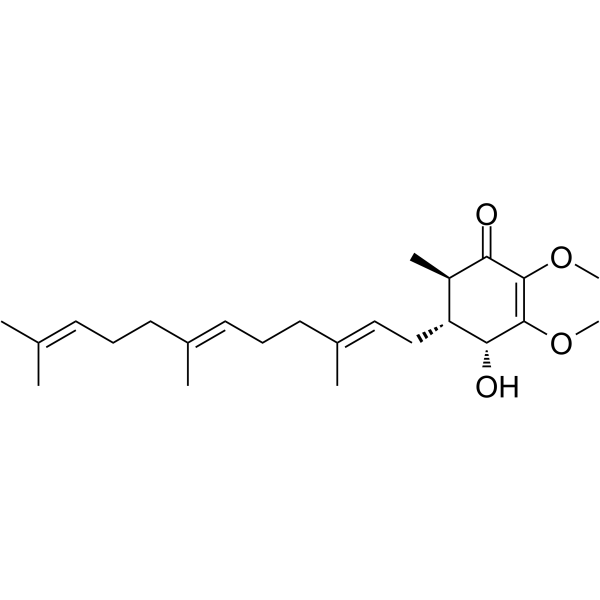| Description |
Antroquinonol ((+)-Antroquinonol), a ubiquinone derivative from the mushroom Antrodia camphorata, has hepatoprotective, anti-inflammatory, and anti-cancer effects[1]. Antroquinonol can be used for the research of colon cancer[2]. Antroquinonol reduces oxidative stress by enhancing the Nrf2 signaling pathway and inhibits inflammation and sclerosis in focal segmental glomerulosclerosis mice[3].
|
| Related Catalog |
|
| In Vitro |
Antroquinonol is a ubiquinone derivative from A.camphorata[2]. Antroquinonol inhibits cell growth and suppresses the migratory/invasive ability of human colon cancer cells. Antroquinonol at high concentrations (40-80 μM) exhibits growth inhibitory activities in the three colon cancer cell lines, whereas low concentrations of Antroquinonol (2.5-20 μM) shows modest growth inhibition[2]. Antroquinonol possesses the ability to inhibit breast cancer migration/invasion by inhibiting the EMT and MMP-9 gene expression[2]. Antroquinonol has inducible nitric oxide synthase (iNOS) inhibitory activity in lipopolysaccharide (LPS)-activated macrophages, anti-inflammatory activity in macrophage cell cultures by reducing the production of tumor necrosis factor-α and interleukin (IL)-1β, and anti-cancer activity against hepatoma cells[3]. Cell Viability Assay[2] Cell Line: The human HCT15, HCT116, and LoVo colon cancer cell lines Concentration: 0, 2.5, 5, 10, 20, 40, and 80 μM Incubation Time: 24 hours Result: The GI50s on HCT15 and LoVo cells were 34.8±0.07 and 17.9±0.07 μM, and the GI50 on HCT116 cells was >80 μM.
|
| In Vivo |
Antroquinonol is a major active component of a mushroom, namely Antrodia camphorate, and it has inhibitory effects on nitric oxide production and inflammatory reactions.Antroq ameliorates proteinuria, improves renal function, and decreases renal lesions, including EPHL, a severe index of glomerular injury, in FSGS mice[3]. Animal Model: 8-week-old female BALB/c mice[3] Dosage: 50 mg/kg Administration: Given daily by gavage until sacrifice Result: Disease-control FSGS mice treated with vehicle showed increased urine protein levels from day 7 after induction of FSGS that continued to increase to the end of the study at day 21. This effect was almost completely suppressed in FSGS mice treated with Antroq, their levels being similar to those in normal control mice.
|
| References |
[1]. Zhen-Wei Yi, et al. Antrodin A from mycelium of Antrodia camphorata alleviates acute alcoholic liver injury and modulates intestinal flora dysbiosis in mice. J Ethnopharmacol. 2020 May 23;254:112681. [2]. Hsien-Chun Lin, et al. Antroquinonol, a Ubiquinone Derivative from the Mushroom Antrodia camphorata, Inhibits Colon Cancer Stem Cell-like Properties: Insights into the Molecular Mechanism and Inhibitory Targets. J Agric Food Chem.2017 Jan 11;65(1):51-59. [3]. Pei-Yi Tsai, et al. Antroquinonol reduces oxidative stress by enhancing the Nrf2 signaling pathway and inhibits inflammation and sclerosis in focal segmental glomerulosclerosis mice. Free Radic Biol Med. 2011 Jun 1;50(11):1503-16.
|
